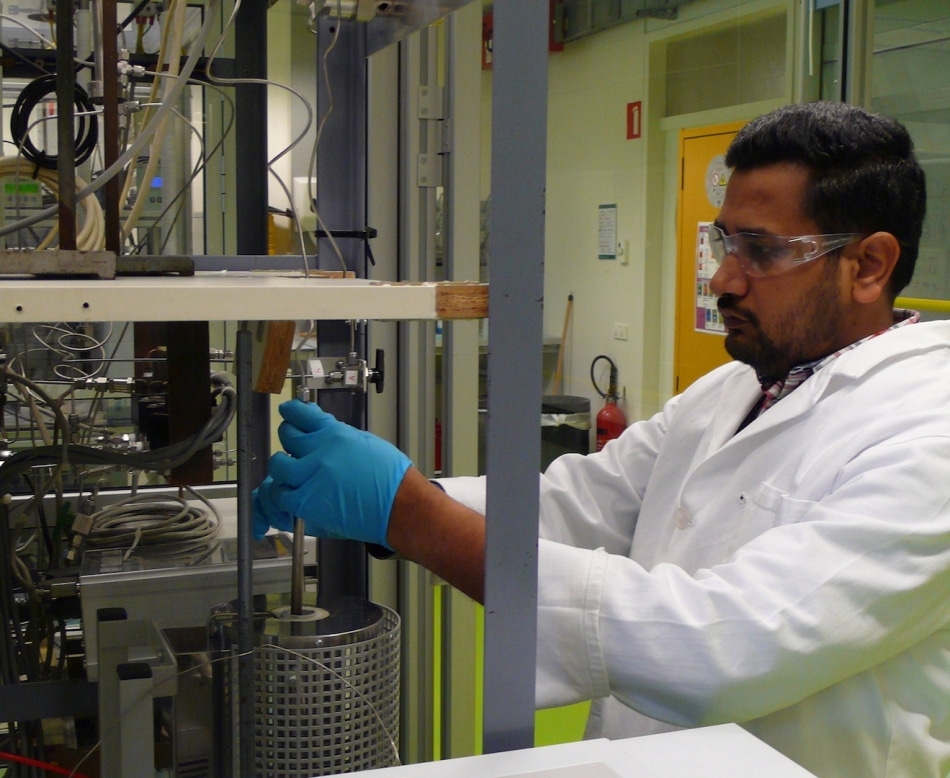Apr 7 2017
A new catalyst capable of converting carbon dioxide (CO2) to carbon monoxide (CO) in an efficient manner has been invented by researchers from the University of Amsterdam (UvA). This invention that will be patented very soon allows the sustainable utilization of CO2, which is a potent greenhouse gas connected with climate change. Additionally, this invention will be able to provide a practical way that will help convert CO2 to useful chemicals if it becomes successful on a bigger scale.
 Dr Edwin S. Gnanakumar operating the catalytic flow. Credits: HIMS/UvA
Dr Edwin S. Gnanakumar operating the catalytic flow. Credits: HIMS/UvA
UvA chemists Edwin Gnanakumar and Shiju Raveendran, researchers behind this invention, are working towards commercializing this catalyst with the help of the university’s technology transfer office, Amsterdam Innovation Exchange (IXA).
From waste to resource
CO2 is a trace gas present in the earth’s atmosphere and plays a vital role in regulating the surface temperature of the planet by trapping heat. CO2 is also considered to be a potent greenhouse gas even though it plays a vital part in the carbon cycle of the planet. The level of atmospheric CO2 has seen a steady increase since the industrial revolution due to human activity and is also believed to be behind the present episode of global warming.
Practical solutions are needed in the field of chemistry to reduce atmospheric CO2 by using the gas as a resource instead of treating it as a waste product. However, it is indeed difficult to use CO2 as a raw material and convert it to useful fuels or chemicals because of the molecular stability of the compound. This stability poses complex challenges to attempts to reactivate or activate CO2.
Efficient conversion
This activation problem was addressed by Gnanakumar and Raveendran, working within the UvA’s Sustainable Chemistry research priority area. These researchers invented a catalyst that has the potential to convert CO2 to CO at relatively mild conditions and in an efficient manner. It is then possible to convert the CO to a number of common hydrocarbons by using the existing technology, thus providing an effective way to use CO2.
It was an accidental discovery. We were experimenting for a different product, but the catalyst turned out to be highly selective for CO, better than any reported ones.
Raveendran
The new cost-effective catalyst is prepared in an effortless manner. It is capable of converting CO2 at low temperatures and ambient pressure. Longer-term tests performed in a flow reactor established the fact that the catalyst remains active, thus proving to be promising for the scale-up of applications such as industrial flue gas conversion. The researchers explain that the conversion can be effortlessly employed for handling increased volumes of gases.
CAPITA
The research on the CO2 catalyst is part of the framework of the European research project CAPITA (Catalytic Processes for Innovative Technology Application), co-funded by the Netherlands Organisation for Scientific Research. The consortium also includes the University of Castilla-La-Mancha (Spain), the Technological Educational Institute of Sterea Ellada and the Chemical Process Engineering Research Institute (Greece) as well as three companies: Hellenic Petroleum Renewables (Greece), GRAPHENANO (Spain), and Delft Solid Solutions (Netherlands).